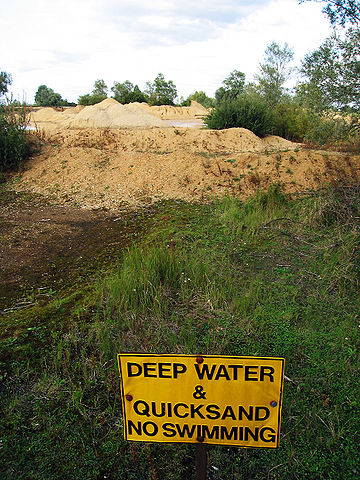
What causes quicksand? It forms in saturated loose sand when the sand is suddenly agitated.
Quicksand is an example of a non-Newtonian fluid. That means it is a liquid, but has the properties of a solid when the pressure applied to it changes. A Newtonian fluid is a liquid such as water that flows exactly the same no matter how much stress is applied to it. Yogurt is a non-Newtonian fluid, as are ketchup and corn starch in water.
Quicksand forms when water saturates loose sand. Although, it doesn’t have to be sand. It can be any coarse granular material, such as sand, silt, clay, or soil. The water flows out of the ground and enters the sand. A little bit of water can make sand more finely packed because it increases the friction of the sand, causing it to stick together more closely. However, if more water is added, the sand particles completely lose their friction. They can slip apart and over each other very easily. It becomes a liquified pool of sand.
When there is no pressure or force applied to the sand, it appears to be solid. However, when force is applied, such as when someone stands on it or when it is shaken, it loses its viscosity and becomes a liquid. The water and the sand separate and lumps of solid sand form. Anyone standing on the quicksand will start to sink when the water and sand separate and then be trapped by the solidifying sand.
Movies always show people being swallowed up by quicksand, but this is not actually possible. For starters, quicksand pits are usually not very deep. Usually, they are half a meter to one and a half meters deep. And, secondly, humans are not dense enough to sink in quicksand. The density of the human body is about 1 gram per cubic centimeter and the density of quicksand is about 2 grams per cubic centimeter, which is more dense than water. Water has a density of slightly less than a human body and the Dead Sea, which we can float on easily, has a density of 1.24 g/cm3. We can float on quicksand more easily than we could float in the Dead Sea. If you fall into quicksand, you might sink up to your waist, but then you would stop sinking, assuming the quicksand was deep enough to sink into, which it most likely wouldn’t be.
The problem with quicksand is that if you were to sink into it up to your waist, it would be very hard to get out because of the weight of the sand. People who fall into quicksand usually panic and flail around a lot, trying to get out. The motion of their limbs causes the quicksand to vibrate more and they sink. When they stop thrashing, the sand settles, kind of like concrete. When you struggle, the water and the sand separate and when you stop struggling the dense sand encases whatever part of you is in the quicksand. You now have to try and get yourself out of solid sand that has almost no viscosity.
So, how do you get out of quicksand? The trick is to make very slow twisting movements. If you do this, you can make a slight gap between your legs and the sand, which will let some of the water that has saturated the quicksand flow in. This water will reenter the solid sand and loosen it up. Lots of slow twisting movements coupled with your natural buoyancy means that you will free yourself eventually.
People do die because of quicksand, but it is not the quicksand that kills them. Quicksand needs a supply of water to form, so they are usually near rivers or the sea. People have drowned because they have become trapped in quicksand and the tide has come in before they can free themselves.
Quicksand is not the only type of soil that can liquify and it doesn’t always need water. Earthquakes can shake the ground up enough that it liquefies. This can be especially dangerous because the foundations of buildings fail, and they collapse.
In theory, if there was an earthquake and a deep enough pit of dry sand, someone could be sucked down to their death, but this has never happened. Grain silos are an example of what might happen. Every year, several people drown in grain silos around the world. People are not supposed to enter a grain silo, but they do for various reasons, and they can easily get sucked down into the grain. In the same way as with quicksand, if you get sucked up to your knees, it is extremely difficult to get out and pretty much impossible without professional help if it reaches your chest.
So, what causes quicksand? Loose sand is saturated with water, which reduces the friction of the sand. When a force is applied to the sand, the water and sand separate and anything on the sand will sink into it. And this is what I learned today.
Sources
https://en.wikipedia.org/wiki/Quicksand
https://science.howstuffworks.com/environmental/earth/geology/quicksand.htm
https://www.nationalgeographic.com/science/article/quicksand-science-why-it-traps-how-to-escape
https://www.allthingsnature.org/what-is-quicksand.htm
https://wonderopolis.org/wonder/Why-Do-You-Sink-in-Quicksand
